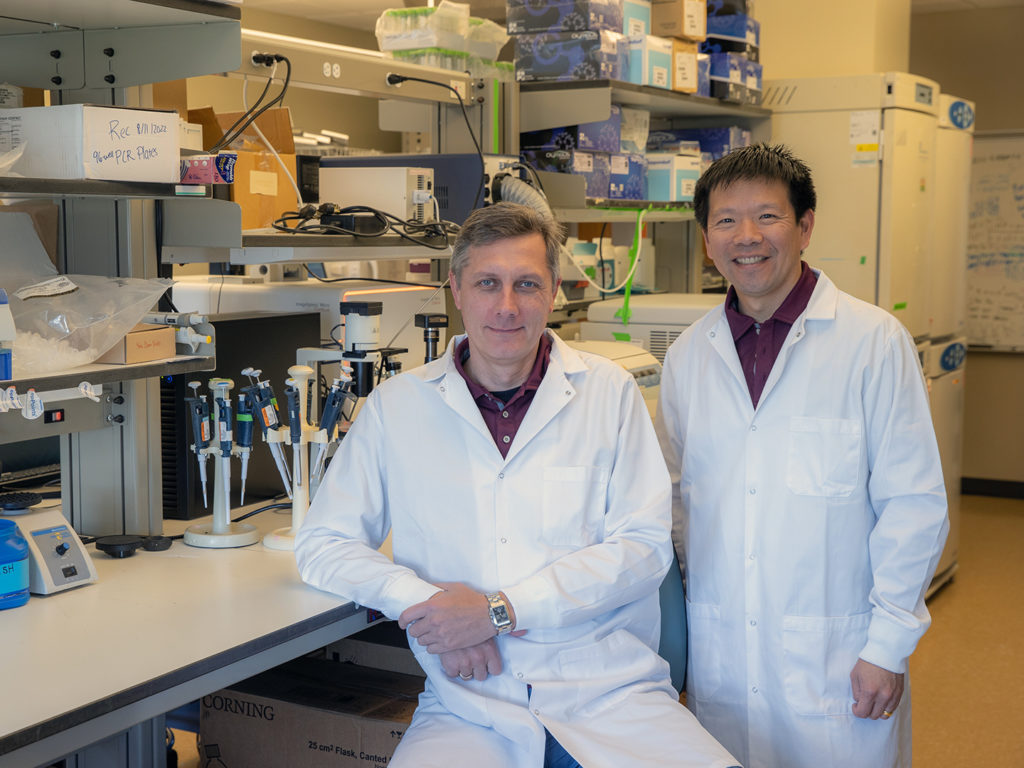Texas A&M Researchers Developing New Approach For Analyzing Chemical Mixtures
Story by Megan Myers, VMBS Communications

Drs. Weihsueh Chiu and Ivan Rusyn, professors at the Texas A&M School of Veterinary Medicine & Biomedical Sciences (VMBS), have received one of 11 new research grants from the U.S. Environmental Protection Agency (EPA) as part of an initiative to find novel ways to assess the toxicity of chemical mixtures.
While toxicology studies have traditionally focused on the effects of single chemicals, chemicals in the air, water, soil, food, and commercial products are often present as mixtures that can be released into the environment through activities like burning coal or through disaster events in areas with extreme pollution.
Many of these mixtures are well-characterized, but others can contain up to thousands of unknown components. Understanding how the overall mixtures affect human, animal, and environmental health is important for those who come into contact with them.
“Mixtures are the most difficult challenge in toxicology because they can have an infinite number of components,” said Rusyn, a University Professor of toxicology. “You can try to figure each one out but still not solve the overall problem because every sample will be a different mixture.”
Rusyn and Chiu aim to develop a new approach for analyzing chemical mixtures that will look at both mixtures as a whole and the major individual components, rather than using the traditional method of determining every component present.
Their three-year project will use the $750,000 EPA grant to develop a new, hybrid approach—combining toxicological, analytical, and modeling methods—for analyzing chemical mixtures found in the environment and determining their potential hazard. By delivering rapid results, this new method will support decision making by first responders and community leaders working to clean up chemical mixtures.
Utilizing Accurate Samples
The team will conduct their research using samples of chemical mixtures previously collected by the Texas A&M Superfund Research Center’s environmental sampling activities following natural disasters such as Hurricane Harvey and Hurricane Florence.
“The EPA needs solutions for real-life mixtures, where they’re not just polycyclic hydrocarbons or pesticides, but really a mixture of many more diverse chemicals,” Rusyn said. “A good example of this challenge is Superfund sites (abandoned hazardous waste sites) that have multiple chemicals. If the site gets flooded, it’s not just one type of chemical that’s going to get out, it’s going to be a mixture of many types of compounds.
“To propose a project that is ambitious but not completely unrealistic, we looked at what samples we already had and found a new, creative way of using that information,” he said. “We were anticipating this type of announcement (for funding opportunities) and we were building up the infrastructure and data sets for 10 years or more; now, this is a perfect chance for us to apply our data and be very efficient.”
The team also will be testing complex substances known as “unknown or variable composition, complex reaction products or biological materials,” or UVCBs.
UVCBs are categorized based on their active ingredients and can include products such as gasoline, motor oil, or cooking oil; they are regulated like a drug or pesticide.
“UVCBs are still manufactured according to certain specifications, but it’s acknowledged that we may not always know what’s in there and that every time we make it, it will be variable in composition,” Rusyn said. “The solutions (the new testing methods) that we’re trying to create will work for both real-life mixtures and UVCBs.”
Taking A New Approach
The research project will involve four major aims, the first of which is using diverse data types to group around 1,000 different individual chemicals based on what organs they may affect.
“Currently, almost all of the existing groupings of chemicals are based on chemical structure; we want to figure out which ones are going to affect a common target through laboratory testing using cells representing different organs in order to be more biologically relevant,” Chiu said.
“Our reasoning is that if we use cells from different human organs—the major ones that are usually the major targets for toxicity—we can test the hypothesis that certain compounds will be specific to certain tissues,” he continued.
For the second and third aims, they will be testing the whole mixture as well as getting information on the individual components and then using novel statistical methods to try to determine which are the most likely components causing effects, either individually or in combination.
Finally, the fourth aim will involve demonstrating how these new methods can provide rapid results that can be utilized in real-life situations.
“Our final step is a translation from research to practice, determining how we can use these new experimental approaches and data to actually make decisions on cleaning up a site, remediation, or on a regulatory level,” Chiu said.
Rusyn and Chiu are collaborating on this project with two colleagues from North Carolina State University, Drs. Yihui Zhou and Fred Wright.
“I’m very grateful to the National Institute of Environmental Health Sciences, the EPA, and Texas A&M for giving us this opportunity by supporting previous work that formed a foundation for this exciting project,” Rusyn said.
###
For more information about the Texas A&M College of Veterinary Medicine & Biomedical Sciences, please visit our website at vetmed.tamu.edu or join us on Facebook, Instagram, and Twitter.
Contact Information: Jennifer Gauntt, Director of VMBS Communications, Texas A&M College of Veterinary Medicine & Biomedical Sciences, jgauntt@cvm.tamu.edu, 979-862-4216


